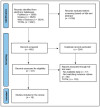A Systematic Review of Lung Autopsy Findings in Elderly Patients after SARS-CoV-2 Infection
- PMID: 36902856
- PMCID: PMC10004532
- DOI: 10.3390/jcm12052070
A Systematic Review of Lung Autopsy Findings in Elderly Patients after SARS-CoV-2 Infection
Abstract
Although COVID-19 may cause various and multiorgan diseases, few research studies have examined the postmortem pathological findings of SARS-CoV-2-infected individuals who died. Active autopsy results may be crucial for understanding how COVID-19 infection operates and preventing severe effects. In contrast to younger persons, however, the patient's age, lifestyle, and concomitant comorbidities might alter the morpho-pathological aspects of the damaged lungs. Through a systematic analysis of the available literature until December 2022, we aimed to provide a thorough picture of the histopathological characteristics of the lungs in patients older than 70 years who died of COVID-19. A thorough search was conducted on three electronic databases (PubMed, Scopus, and Web of Science), including 18 studies and a total of 478 autopsies performed. It was observed that the average age of patients was 75.6 years, of which 65.4% were men. COPD was identified in an average of 16.7% of all patients. Autopsy findings indicated significantly heavier lungs, with an average weight of the right lung of 1103 g, while the left lung mass had an average weight of 848 g. Diffuse alveolar damage was a main finding in 67.2% of all autopsies, while pulmonary edema had a prevalence of between 50% and 70%. Thrombosis was also a significant finding, while some studies described focal and extensive pulmonary infarctions in 72.7% of elderly patients. Pneumonia and bronchopneumonia were observed, with a prevalence ranging from 47.6% to 89.5%. Other important findings described in less detail comprise hyaline membranes, the proliferation of pneumocytes and fibroblasts, extensive suppurative bronchopneumonic infiltrates, intra-alveolar edema, thickened alveolar septa, desquamation of pneumocytes, alveolar infiltrates, multinucleated giant cells, and intranuclear inclusion bodies. These findings should be corroborated with children's and adults' autopsies. Postmortem examination as a technique for studying the microscopic and macroscopic features of the lungs might lead to a better knowledge of COVID-19 pathogenesis, diagnosis, and treatment, hence enhancing elderly patient care.
Keywords: COVID-19; SARS-CoV-2; autopsy; elderly patients; old age; severe infection.
Conflict of interest statement
The authors declare no conflict of interest.
Similar articles
-
Postmortem lung biopsies from four patients with COVID-19 at a tertiary hospital in Cape Town, South Africa.S Afr Med J. 2020 Oct 19;110(12):1195-1200. doi: 10.7196/SAMJ.2020.v110i12.15290. S Afr Med J. 2020. PMID: 33403965
-
[A pathological report of three COVID-19 cases by minimal invasive autopsies].Zhonghua Bing Li Xue Za Zhi. 2020 May 8;49(5):411-417. doi: 10.3760/cma.j.cn112151-20200312-00193. Zhonghua Bing Li Xue Za Zhi. 2020. PMID: 32172546 Chinese.
-
Morphopathological features induced by SARS-CoV-2 infection - a series of 57 autopsies.Histol Histopathol. 2023 May;38(5):513-524. doi: 10.14670/HH-18-561. Epub 2022 Nov 23. Histol Histopathol. 2023. PMID: 36504081
-
Histopathological Findings in COVID-19 Cases: A Systematic Review.Cureus. 2022 Jun 1;14(6):e25573. doi: 10.7759/cureus.25573. eCollection 2022 Jun. Cureus. 2022. PMID: 35784976 Free PMC article. Review.
-
Postmortem Findings Associated With SARS-CoV-2: Systematic Review and Meta-analysis.Am J Surg Pathol. 2021 May 1;45(5):587-603. doi: 10.1097/PAS.0000000000001650. Am J Surg Pathol. 2021. PMID: 33481385 Free PMC article.
Cited by
-
Interstitial Capillary Congestion and Diffuse Alveolar Damage: Incidental or Factual Findings in the Lungs of Autopsy Cases Positive for Coronavirus Disease-19.Ann Afr Med. 2025 Apr 1;24(2):391-397. doi: 10.4103/aam.aam_263_24. Epub 2025 Mar 7. Ann Afr Med. 2025. PMID: 40053438 Free PMC article.
-
Virtual histological staining of unlabeled autopsy tissue.Nat Commun. 2024 Feb 23;15(1):1684. doi: 10.1038/s41467-024-46077-2. Nat Commun. 2024. PMID: 38396004 Free PMC article.
-
Unveiling the Pathological Mechanisms of Death Induced by SARS-CoV-2 Viral Pneumonia.Microorganisms. 2024 Feb 24;12(3):459. doi: 10.3390/microorganisms12030459. Microorganisms. 2024. PMID: 38543510 Free PMC article.
-
Immune-Mediated Ocular Surface Disease in Diabetes Mellitus-Clinical Perspectives and Treatment: A Narrative Review.Biomedicines. 2024 Jun 12;12(6):1303. doi: 10.3390/biomedicines12061303. Biomedicines. 2024. PMID: 38927510 Free PMC article. Review.
-
Altered sphingolipid pathway in SARS-CoV-2 infected human lung tissue.Front Immunol. 2023 Oct 4;14:1216278. doi: 10.3389/fimmu.2023.1216278. eCollection 2023. Front Immunol. 2023. PMID: 37868972 Free PMC article.
References
-
- Citu C., Gorun F., Motoc A., Ratiu A., Gorun O.M., Burlea B., Neagoe O., Citu I.M., Rosca O., Bratosin F., et al. Evaluation and Comparison of the Predictive Value of 4C Mortality Score, NEWS, and CURB-65 in Poor Outcomes in COVID-19 Patients: A Retrospective Study from a Single Center in Romania. Diagnostics. 2022;12:703. doi: 10.3390/diagnostics12030703. - DOI - PMC - PubMed
-
- Hrubaru I., Motoc A., Bratosin F., Rosca O., Folescu R., Moise M.L., Neagoe O., Citu I.M., Feciche B., Gorun F., et al. Exploring Clinical and Biological Features of Premature Births among Pregnant Women with SARS-CoV-2 Infection during the Pregnancy Period. J. Pers. Med. 2022;12:1871. doi: 10.3390/jpm12111871. - DOI - PMC - PubMed
-
- Toma A.-O., Prodan M., Reddyreddy A.R., Seclaman E., Crainiceanu Z., Bloanca V., Bratosin F., Dumitru C., Pilut C.N., Alambaram S., et al. The Epidemiology of Malignant Melanoma during the First Two Years of the COVID-19 Pandemic: A Systematic Review. Int. J. Environ. Res. Public Health. 2023;20:305. doi: 10.3390/ijerph20010305. - DOI - PMC - PubMed
Publication types
LinkOut - more resources
Full Text Sources
Miscellaneous


